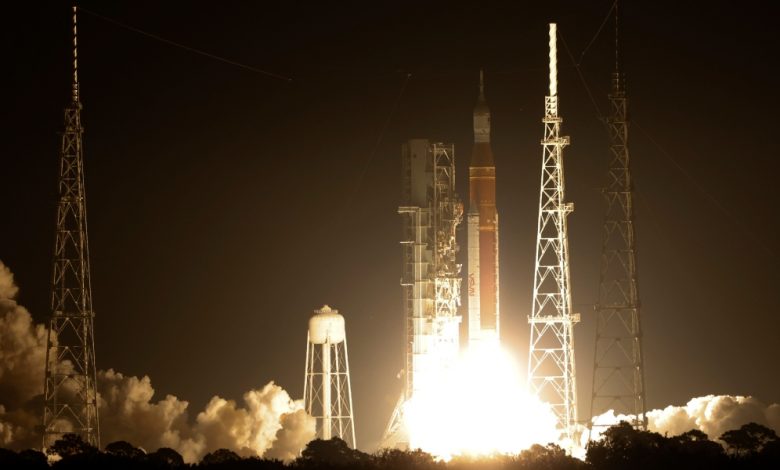NASA’s Artemis rocket launches to the moon 50 years after the end of the Apollo lunar program

NASA’s New Moon rocket lifted off on its debut flight Wednesday with three test dummies on board, taking the US a big step closer to returning astronauts to the lunar surface for the first time since the Apollo program ended 50 years ago.
If all goes well during the three-week tour, the crew capsule will be launched into a wide orbit around the moon and then return to Earth with a splashdown in the Pacific Ocean in December.
After years of delays and billions of dollars in cost overruns, the Space Launch System rocket roared into the sky, ascending from the Kennedy Space Center at 8.8 million pounds (4 million kilograms) of thrust and hitting 160 km/h (100 mph) in seconds. . The Orion capsule sat on its tip and, after less than two hours of flight, shot out of Earth orbit towards the moon.
“It’s a great day,” said NASA Administrator Bill Nelson.
The moonshot follows nearly three months of vexing fuel leaks that bounced the rocket between its hangar and the pad. The rocket was pushed back indoors by Hurricane Ian in late September, but held its own outside as Nicole swept through the area in gusts of more than 80mph last week. Although the wind caused some damage, managers gave the go-ahead for launch.
An estimated 15,000 people thronged the launch site, with thousands more lining the beaches and streets just outside to witness NASA’s long-awaited follow-up to Project Apollo, when 12 astronauts walked on the moon in 1969 and 1972. Crowds also gathered outside the NASA centers in Houston and Huntsville, Alabama, to watch the spectacle on giant screens.
Cheers accompanied the rocket as it rode toward space on a huge plume of flame, with a bright crescent moon glowing and buildings trembling as if struck by a great earthquake.
“For the Artemis generation, this is for you,” exclaimed launch director Charlie Blackwell-Thompson, referring to anyone born after Apollo.
The launch marked the beginning of NASA’s Artemis lunar exploration program, named for Apollo’s mythological twin sister. The space agency aims to send four astronauts around the moon on the next flight in 2024 and land people there as early as 2025.
“You’ve earned your place in history,” Blackwell-Thompson told her team after the start.
The 98-meter-long SLS is the most powerful rocket ever built by NASA, with more thrust than either the space shuttle or the mighty Saturn V that carried humans to the moon. A series of hydrogen leaks plagued summer launch attempts as well as countdown tests. A new leak erupted at a new location during Tuesday night’s refueling, but an emergency response team managed to tighten the failed valve to the panel. Then a US Space Force radar station failed, causing another mess, this time to replace an Ethernet switch.
“The rocket, it’s alive. It creaks. It makes venting noises. It’s pretty scary. … My heart was pumping. My nerves were shattered,” said Trent Annis, one of the three men who entered the hazard zone to patch the leak Tuesday night.
Orion should reach the moon by Monday, more than 230,000 miles (370,000 kilometers) from Earth. After approaching within 80 miles (130 kilometers) of the Moon, the capsule will enter a distant orbit extending some 40,000 miles (64,000 kilometers) beyond.
The $4.1 billion test flight is scheduled to last 25 days, roughly as long as crews will be on board. The space agency intends to push the spacecraft to its limits and uncover any problems before astronauts buckle up. The mannequins — NASA calls them moonequins — are equipped with sensors to measure things like vibration, acceleration, and cosmic rays.
The rocket should have completed its test run by 2017. Government officials estimate that NASA will have spent $93 billion on the project by 2025.
Ultimately, NASA hopes to have a base on the moon and send astronauts to Mars by the late 2030s or early 2040s.
But many hurdles still have to be overcome. The Orion capsule will only take astronauts to lunar orbit, not to the surface.
NASA has commissioned Elon Musk’s SpaceX to develop Starship, the 21st century answer to Apollo’s lunar module. Starship will ferry astronauts back and forth between Orion and the lunar surface, at least for the first voyage in 2025. The plan is to have Starship, and eventually other companies’ landers, stationed in orbit around the moon, ready for use when new Orion crews emerge.
Echoing an argument made in the 1960s, Duke University historian Alex Roland challenges the value of human spaceflight, saying that robots and remote-controlled spacecraft could do the job cheaper, more efficiently, and safely.
“In all these years, no evidence has emerged to justify our investment in human spaceflight, apart from the prestige that comes with that conspicuous consumption,” he said.
NASA is waiting for this test flight to be over before unveiling the astronauts who will be on the next one and those who will follow in the footsteps of Apollo 11’s Neil Armstrong and Buzz Aldrin.
Most of NASA’s 42 active astronauts and 10 trainees weren’t even born when Gene Cernan and Harrison Schmitt, the Apollo 17 moonwalkers, ended the era 50 years ago next month.
“We jump out of our spacesuits with excitement,” astronaut Christina Koch said on Tuesday.
After a nearly year-long mission to the space station and an all-female spacewalk, 43-year-old Koch is on NASA’s shortlist for a moon flight. So did astronaut Kayla Barron, 35, who finally got to witness her first rocket launch, not counting her own a year ago.
“It took my breath away and I was in tears,” Barron said. “What an incredible achievement for this team.”
Sign up for the Fortune Features Email list so you don’t miss our biggest features, exclusive interviews and investigations.



